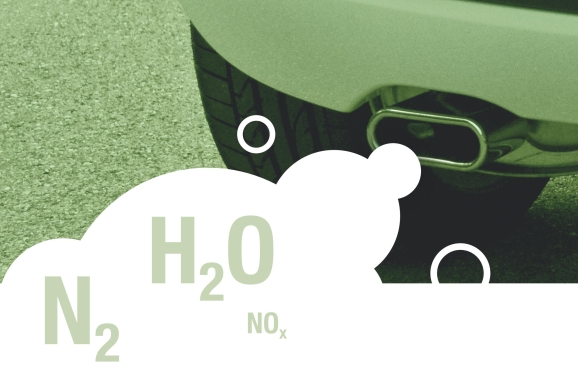Pump drive from St. Georgen helps reduce nitrogen oxides in diesel emissions.
The EURO 6 standard reduces harmful emissions from diesel engines significantly – those of carbon particulate matter and those of nitrogen oxide (NOx). The stringent limits that take effect 1st September 2014 cannot be met just by improving combustion in the engine. Therefore, many manufacturers of commercial vehicles and passenger cars use what is known as a Selective Catalytic reduction System (SCR). In this form of exhaust gas treatment, nitrogen oxide emissions are reduced by adding an ultrapure urea solution. A high-performance, reliable pump with an ebm-papst drive injects the urea additive. “This will become standard in commercial vehicles,” states Peter Metzger, Head of Sales Automotive at ebm-papst in St. Georgen, confidently. For diesel engines of lorries weighing over 3.5 tonnes, the legislation dictates that the exhaust gases must be treated such that they are largely free of nitrogen oxides. Compared to the EURO 5 standard, the NOx limits are being decreased by 80 per cent, to 500 mg/kWh. “For passenger cars, this is largely dependent on the type of engine and future legislation. The system is not absolutely necessary for diesel engines with small volumes, as the emissions are already below the currently valid limits,” Metzger explains. “However, we expect the limits to be made even more stringent.”
To render nitrogen oxide harmless, power plants have long added ammonia to the flue gas. However, ammonia is a highly irritating, poisonous gas. It is a hazardous material that can be transported only in pressurised liquid form. Therefore, ammonia is unsuitable for mobile use in vehicles. It takes a chemical trick to enable the cleaning process in lorries and passenger cars: The vehicle-compatible SCR uses a solution of urea in water as an additive, which breaks down into its initial components only when strongly affected by heat. This solution is now tried and tested. The exhaust gas, which is practically free of carbon particulate matter, exits the engine into the exhaust gas system. Here, the additive – urea dissolved in distilled water – is metered. The high temperatures break down the urea immediately into carbon dioxide and ammonia. At the downstream catalytic converter, this reacts with the nitrogen oxides to create water and nitrogen – thus cleaning the exhaust gas.
On average, this process consumes an amount of saturated urea solution equal to about six per cent that of the fuel. Thus a 60-litre tank of additive lasts about 4,000 kilometres if the diesel fuel consumption of a lorry is 25 litres per 100 kilometres. However, the fuel consumption also becomes lower at the same time, as the diesel engine runs more efficiently. For this method of decreasing nitrogen oxide emissions, Bosch developed a pumping module and a dosing unit. The reduction of nitrogen oxides must work reliably over a wide flow rate range. Because urea solution becomes a solid at below-zero temperatures, an internal heater in the dispensing device must thaw the lines quickly after the engine starts. The quantity of additive that the pump injects directly into the exhaust gas system must be adapted exactly to the amount of nitrogen oxide in the exhaust gas. During this process, a closed-loop control system with the actual value set by an NOx sensor regulates the timing of the metering of the additive for each nozzle at a cycle of 1 Hertz. At a system pressure of 9 bar, the dosing unit guarantees the required mass flow rate: from 36 grams per hour when idling up to 7.2 kilograms at full load. If the pressure drops, the denitrification is incomplete – a demanding task for the pump drive. Therefore, Bosch incorporated the drive xperts of ebm-papst St. Georgen into the development. “Bosch was looking for a partner with whom they could develop the motor and electronics,” Metzger adds.
This resulted in a modular drive concept with EC motor. The modular design makes it possible to keep following the current state of changing legal requirements. The pump, hydraulic components and electronics can be replaced individually. The drive experts from Germany’s Black Forest region devised an elegant solution to this challenge: The external rotor motors they produce are known for very good synchronous running and high torque, even at start-up. The drives are also highly compact. The developers made use of these basic properties and further improved the drive for automotive applications. They optimised the electromagnetic compatibility for mobile use and designed the bearing system and all other components for a long service life in the required temperature range. The load profiles are typical for automotive and place a load on the engine not only when it is in operation, but also when it is not moving. In continuous operation at a constant load, this is over four and a half years, as Metzger stresses: “In a lorry, this corresponds to a service life of over one million kilometres.” The multi-pole motor sits together with the electronic commutation on a board and has variable lengths. This way the overall height of eight millimetres provides sufficient output for operating a car. The 13-millimetre version corresponds to the larger mass flow rate for industrial vehicles. Both are equipped with a wide voltage input and therefore enable use in a 12/24-volt vehicle electrical system. The high requirements demanded by the automotive industry for supplier components effortlessly fulfil the 100 per cent quality control of fully automated manufacturing. Peter Metzger underscores that exhaust gas treatment with SCR will become an important competitive factor for the automotive industry in the coming years. “The environmental requirements will also continue to rise substantially internationally. For that reason, markets in which exhaust gas treatment has hardly played a role to date will quickly incorporate it.”
Clean standard
The dilemma of consumption and carbon particulate matter vs. nitrogen oxide


Leave a comment